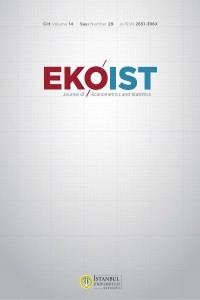Finansal Zaman Serileri Tahmininde Hibrit Yaklaşımlar: Bir Hisse Senedi Piyasası Uygulaması
Hibrit Yaklaşımlar, Makine Öğrenimi, Hisse Senedi Piyasası, ARIMA, GARCH, SVM, LSTM
Hybrid Approaches in Financial Time Series Forecasting: A Stock Market Application
Hybrid time series, machine learning, ARIMA GARCH, SVM, LSTM, stock market, Hibrit Yaklaşımlar, Makine Öğrenimi, Hisse Senedi Piyasası,
___
- Bildirici, M. & Ersin, Ö. Ö. (2009). Improving forecasts of GARCH family models with the artificial neural networks: An application to the daily returns in Istanbul Stock Exchange, Expert Systems with Applications, 36(4), 7355-7362. doi:10.1016/j.eswa.2008.09.051.
- Bollerslev, T. (1986). Generalized autoregressive conditional heteroskedasticity. Journal of Econometrics, 31(3), 307–327.
- Box, G., & Jenkins, G.M., (1970). Time series analysis: forecasting and control. Holden-Day, San Francisco,CA.
- Box, G.E., Jenkins, G.M., Reinsel, G.C., & Ljung, G.M. (2015), Time Series Analysis: Forecasting and Control, John Wiley and Sons.
- Chen, K., Zhou, Y., Dai, F. (2015). A LSTM-based method for stock returns prediction: A case study of China stock market. In Proceedings of the 2015 IEEE international conference on big data (Big Data) IEEE, (pp. 2823–2824).
- Chiang, W.C.,Urban, T.L., & Baildridge, G.(1996), A neural network approach to mutual fund net asset value forecasting, Omega 24 (2), 205–215.
- de Mattos Neto, P.S., Cavalcanti, G.D., & Madeiro, F.(2017), Nonlinear combination method of forecasters applied to PM time series, Pattern Recognit. Lett. 95, 65–72.
- Domingos S.O., Oliveira de J.F.L., & Mattos Neto de P.S.G., (2019), An intelligent hybridization of ARIMA with machine learning models for time series forecasting, Knowledge-Based Systems 175, pp.72-86
- Engle, R. F. (1982). Autoregressive conditional heteroscedasticity with estimates of he variance of United Kingdom inflation. Econometrica: Journal of the Econometric Society, 987–1007.
- Fayyad, R. Uthurusamy (Eds.), Proceedings of the First International Conference on Knowledge Discovery and Data Mining, AAAI Press, Menlo Park, CA.
- Hyndman, Rob. 2006. “Another Look at Forecast Accuracy Metrics for Intermittent Demand.” Foresight: The International Journal of Applied Forecasting, 4, 43–46.
- Khashei, M., & Bijari, M.(2010), An artificial neural network (p, d, q) model for time series forecasting, Expert Syst. Appl. 37(1), 479–489.
- Khashei, M., Bijari, M.(2011), A novel hybridization of artificial neural networks and ARIMA models for time series forecasting, Appl. Soft Comput. 11(2), 2664–2675.
- Kim K-J., (2003) Financial time series forecasting using support vector machines, Neurocomputing 55, pp.307 – 319.
- Kim, H.Y., & Won, C.H. (2018), Forecasting the volatility of stock price index: A hybrid model integrating LSTM with multiple GARCH-type models, Expert Systems With Applications 103, 25–37.
- Maknickiené N., & Maknickas, A. (2012, May). Application of neural network for orecasting of exchange rates and forex trading, In Proceedings of the 7th international scientific conference on business and management pp. 10–11.
- Markham, L.S., & Rakes T.R. (1998), The effect of sample size and variability of data on the comparative performance of artificial neural networks and regression, Comput. Oper. Res. 25 251–263.
- Muller, K.R., Smola, J.A., & Scholkopf, B.(1997), Prediction time series with support vector machines, Proceedings of International Conference on Artificial Neural Networks, Lausanne, Switzerland, pp. 999–1004.
- Nelson, D. B. (1991). Conditional heteroskedasticity in asset returns: Anew approach. Econometrica: Journal of the Econometric Society, pp. 347–370.
- Pérez-cruz, F., Afonso-rodríguez, J. A. & Giner, J. (2003), Estimating GARCH models using support vector machines, Quantitative Finance, 3(3), pp.163-172. doi:10.1088/1469-7688/3/3/302
- Panigrahi, S., & Behera, H.(2017), A hybrid ETS–ANN model for time series forecasting, Eng.Appl. Artif. Intell. 66, 49–59.
- Scholkopf, B., Burges, C., &Vapnik, V.(1995), Extracting support data for a given task, in: U.M. Sima, S.N., Neda, T., &Akbar, S.N. (2018), A Comparison of ARIMA and LSTM in Forecasting Time
- Series,2018 17th IEEE International Conference on Machine Learning and Applications (ICMLA) Vapnik, V.N.(1995), The Nature of Statistical Learning Theory, Springer, New York .
- Yaser, S.A.M., & Atiya, A.F. (1996), Introduction to financial forecasting, Appl. Intell. 6, 205–213.
- Zhang G.P., Patuwo E.B., & Hu M.Y., (1998) Forecasting with artificial neural networks: the state of the art, Int. J. Forecasting 14, pp.35–62.
- Zhang, G.P. (2003), Time series forecasting using a hybrid ARIMA and neural network model, Neurocomputing, 50,159 – 175.
- Yayın Aralığı: Yılda 2 Sayı
- Yayıncı: İstanbul Üniversitesi
Chasing Volatility of USD/TRY Foreign Exchange Rate: The Comparison of CARR, EWMA, and GARCH Models
Nazan ŞAK, Hatice Gökçen ÖCAL ÖZKAYA
Seda KARAKAŞ GEYİK, Mehmet Hakan SATMAN, Gülin KALYONCU
Association Rules Mining on Retail Data
Hatice DAĞASLANI, Özlem DENİZ BAŞAR
Türkiye’de Gıda Fiyatları, Döviz Kuru ve Petrol Fiyatları Arasındaki Asimetrik Ilişki
Hüseyin İÇEN, Nimet Melis ESENYEL İÇEN, Buğra POLAT
Uluslararası Sermaye Akışlarında Ani Duruş: Türkiye Örneği
Emine Ebru ER, Cihan TANRIÖVEN
OECD Ülkelerinde Demokrasinin Çevresel Bozulma Üzerindeki Etkisi
